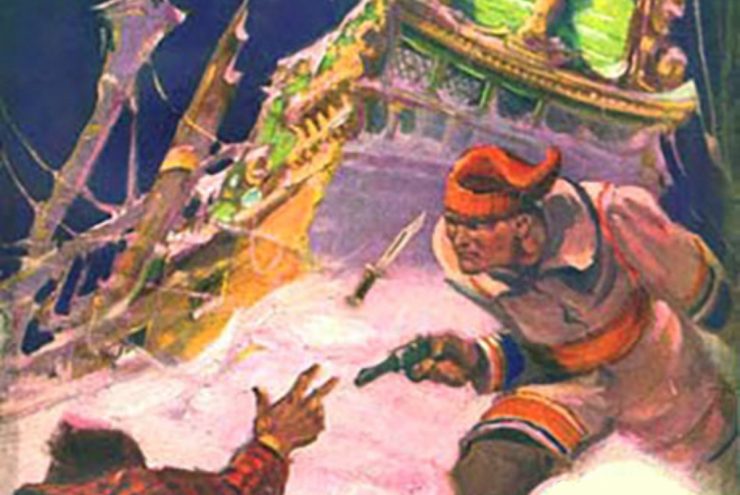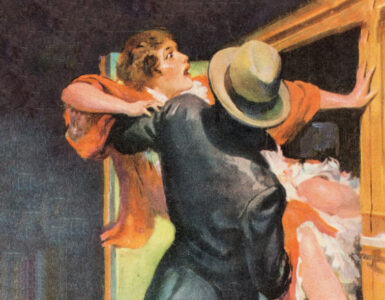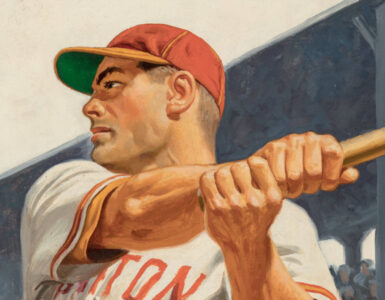 Pulp magazines are named for the cheap paper on which they were printed. Frank A. Munsey pioneered the format in 1896 with The Argosy.
Pulp magazines are named for the cheap paper on which they were printed. Frank A. Munsey pioneered the format in 1896 with The Argosy.
Over the next twenty-five years, pulps began to pick up steam with the introduction of The Popular Magazine, The All-Story Magazine, The Blue Book Magazine, The Railroad Man’s Magazine, Adventure, and Street & Smith’s specialized titles, Detective Story Magazine, Western Story Magazine, and Love Story Magazine.
During the 1920s, the pulp industry grew by leaps and bounds, with publishing legends such as Black Mask, Weird Tales, and Amazing Stories taking root. Existing publishers expanded their magazine lines, while new publishers entered the fray. One of the latter was Fiction House, founded in the spring of 1921, by a pair of Irishmen who worked in magazine circulation.
John W. Glenister was born in New York City in 1874. He started selling papers at the age of nine. At fourteen, he hitched a ride on a Chicago-bound freight train. He later told Brooklyn’s Sunday Eagle Magazine, “There’s nothing unusual in that, you know. All young boys thirst for adventure.”
In the late 1890s, Glenister became a professional swimmer. After swimming the English Channel in 1897, he gained international notoriety as the first man to cross the Whirlpool Rapids of the Niagara River. Crediting his feat to “Lady Luck,” Glenister quipped, “You must realize that it wasn’t really swimming, but merely keeping above water and keeping my lungs full of air. The currents swirled me over to the other side.”
“Bearcat” Glenister — as he was sometimes called — found himself a celebrity. He was asked to endorse products and speak on the vaudeville circuit. Before long, he was producing plays and working in circulation for Boston and New York City newspapers. When he teamed up with John B. “Jack” Kelly — the circulation manager for Metropolitan Magazine — to found Fiction House, Glenister was the circulation manager for Warner Publications, promoting Field and Stream, The Parisienne, Saucy Stories, The Smart Set, and other magazines.
Jack Kelly and John Glenister launched Fiction House on April 14, 1921 with the former serving as the editor-in-chief and Glenister acting as publisher and president of the new enterprise. Their first pulp magazine — launched during the summer of 1921 — was Action Stories.
Action, stripped to the bone, denuded of all superfluous trimmings, spelt with a capital A . . . no lengthy descriptions, no long-winded digressions . . . Just the stripped action meat of a dramatic, swift-moving plot — laid in any adventurous land under the sun . . .
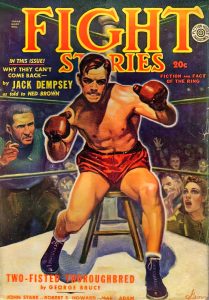 Within a few years, Action Stories was selling 150,000 copies of each issue. By the end of the decade, Kelly and Glenister had added North-West Stories, Lariat Story Magazine, Love Romances, Air Stories, Fight Stories, Wings, Aces, Action Novels, Detective Classics, Detective Book Magazine, and other titles to their pulp line. They had also purchased Frontier Stories from Doubleday in 1929. Most of these magazines ran for many years, lasting into the early 1950s when the entire pulp industry imploded.
Within a few years, Action Stories was selling 150,000 copies of each issue. By the end of the decade, Kelly and Glenister had added North-West Stories, Lariat Story Magazine, Love Romances, Air Stories, Fight Stories, Wings, Aces, Action Novels, Detective Classics, Detective Book Magazine, and other titles to their pulp line. They had also purchased Frontier Stories from Doubleday in 1929. Most of these magazines ran for many years, lasting into the early 1950s when the entire pulp industry imploded.
In June of 1930, not long after an unsuccessful expedition to Ireland to find the next heavyweight boxing champion of the world, John W. Glenister’s health took a turn for the worse. He turned the task of managing Fiction House over to his son-in-law, Thurman T. Scott. Glenister and his wife moved to Santa Monica, California, to be near their oldest daughter and her family.
Not quite two years later, while visiting his partner in California, John B. “Jack” Kelly unexpectedly passed away. He was only 45 years old.
Losing both of its founders in the space of just two years, Fiction House was forced to retrench. Wishing to withdraw from the business, Kelly’s family asked for the liquidation of the company assets. On December 27, 1932, Fiction House indefinitely suspended all its remaining magazines. T. T. Scott, the secretary of Fiction House, assured The New York Times that “publication was only suspended” and would be resumed when economic conditions improved.
For the first six to eight months of 1933, the Fiction House offices were silent as New York’s courts sorted out the company’s finances. Scott and Managing Editor Jack Byrne held down the fort.
On October 7, 1933, Jack Kelly’s widow, Laura A. Kelly, resigned from the company and its affiliated corporations, ending her family’s role in the business. One week later, John Glenister, Fiction House president, told the Los Angeles Times:
The coming of the N.R.A. Blue Eagle heralds a return to normal business conditions, and in reviving Action Stories, Lariat, Frontier Stories, and Wings, I am merely responding to Franklin D. Roosevelt’s campaign for a new deal. Other Fiction House magazines will reappear from time to time as J. F. Byrne, my editor, gets his forces reassembled.
Glenister’s statement made for good press, covering up the company’s legal issues.
Originally asked by his father-in-law to shut down Fiction House, T. T. Scott “sort of fell in love with the business.” With Jack Byrne’s help, Scott was able to gradually resume publishing during the second half of 1933. First came the popular Illustrated Football Annual, followed by Action Stories and Lariat Story Magazine toward year’s end. Wings and Frontier Stories reappeared a month later.
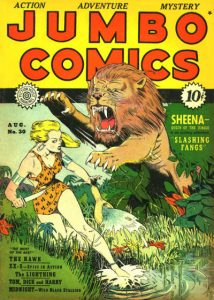 By the fall of 1937, Scott, Jack Byrne, and later, Malcolm Reiss had rescued Fiction House from bankruptcy. Gaining confidence, Scott launched a succession of sports pulps, including the revived Fight Stories, Football Stories, Baseball Stories, and All-American Football Magazine. Later came Jungle Stories, Two Complete Detective Books, Planet Stories, and a very influential line of comic books. The company would eventually publish nearly 30 different comic book titles.
By the fall of 1937, Scott, Jack Byrne, and later, Malcolm Reiss had rescued Fiction House from bankruptcy. Gaining confidence, Scott launched a succession of sports pulps, including the revived Fight Stories, Football Stories, Baseball Stories, and All-American Football Magazine. Later came Jungle Stories, Two Complete Detective Books, Planet Stories, and a very influential line of comic books. The company would eventually publish nearly 30 different comic book titles.
As late as the fall of 1937, John W. Glenister was listed as president on the masthead of Fiction House magazines. This would only change when “Bearcat” succumbed to a stroke. He died on October 17, 1937. His wife, Julia, had passed away six months earlier. Afterward, T. T. Scott became the president and publisher of Fiction House.
At PulpFest 2024, we’ll be celebrating the 150th anniversary of legendary Black Mask editor, Joseph T. “Cap” Shaw. But this week, we honor the 150th anniversary of the birth of the co-founder of the Fiction House line of pulp magazines and comic books, John W. “Bearcat” Gleinister.
Our featured image is excerpted from H. C. Murphy’s cover art for the December 1925 issue of Action Stories, while our lead image is the first issue of Action Stories, dated September 1921. The cover art is by Alton Everett Porter, a commercial artist who lived from 1890 – 1980. He is best known for his work for Mack Trucks. Many thanks to David Saunders for his help in identifying the artist.
Also featured in our post is the Summer 1940 Fight Stories — with cover art by George Gross — and Jumbo Comics #30 — dated August 1941 and featuring cover art by Dan Zolnerowich (as Zolne Rowich).
To learn more about John W. Glenister and the history of Fiction House, pick up copies of The Pulpster #31 and #32. The issues feature the first two parts of “The Home for Action,” an in-depth look at the publisher and its pulp magazines. The third and final segment of “The Home for Action” will appear in The Pulpster #33. All members of PulpFest 2024 will receive a complimentary copy of The Pulpster #33 as part of their registration packet.

